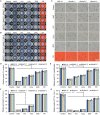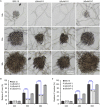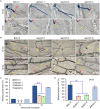A novel Botrytis cinerea-specific gene BcHBF1 enhances virulence of the grey mould fungus via promoting host penetration and invasive hyphal development
- PMID: 31008573
- PMCID: PMC6637910
- DOI: 10.1111/mpp.12788
A novel Botrytis cinerea-specific gene BcHBF1 enhances virulence of the grey mould fungus via promoting host penetration and invasive hyphal development
Abstract
Botrytis cinerea is the causative agent of grey mould on over 1000 plant species and annually causes enormous economic losses worldwide. However, the fungal factors that mediate pathogenesis of the pathogen remain largely unknown. Here, we demonstrate that a novel B. cinerea-specific pathogenicity-associated factor BcHBF1 (hyphal branching-related factor 1), identified from virulence-attenuated mutant M8008 from a B. cinerea T-DNA insertion mutant library, plays an important role in hyphal branching, infection structure formation, sclerotial formation and full virulence of the pathogen. Deletion of BcHBF1 in B. cinerea did not impair radial growth of mycelia, conidiation, conidial germination, osmotic- and oxidative-stress adaptation, as well as cell wall integrity of the ∆Bchbf1 mutant strains. However, loss of BcHBF1 impaired the capability of hyphal branching, appressorium and infection cushion formation, appressorium host penetration and virulence of the pathogen. Moreover, disruption of BcHBF1 altered conidial morphology and dramatically impaired sclerotial formation of the mutant strains. Complementation of BcHBF1 completely rescued all the phenotypic defects of the ∆Bchbf1 mutants. During young hyphal branching, host penetration and early invasive growth of the pathogen, BcHBF1 expression was up-regulated, suggesting that BcHBF1 is required for these processes. Our findings provide novel insights into the fungal factor mediating pathogenesis of the grey mould fungus via regulation of its infection structure formation, host penetration and invasive hyphal branching and growth.
Keywords: Botrytis cinerea; appressorium; host penetration; hyphal branching; infection cushions; sclerotial formation; virulence.
© 2019 The Authors. Molecular Plant Pathology Published by British Society for Plant Pathology and John Wiley & Sons Ltd.
Figures









Similar articles
-
Cyclophilin BcCyp2 Regulates Infection-Related Development to Facilitate Virulence of the Gray Mold Fungus Botrytis cinerea.Int J Mol Sci. 2021 Feb 8;22(4):1694. doi: 10.3390/ijms22041694. Int J Mol Sci. 2021. PMID: 33567582 Free PMC article.
-
The H3K4 demethylase Jar1 orchestrates ROS production and expression of pathogenesis-related genes to facilitate Botrytis cinerea virulence.New Phytol. 2020 Jan;225(2):930-947. doi: 10.1111/nph.16200. Epub 2019 Oct 16. New Phytol. 2020. PMID: 31529514
-
Transcriptome analysis and functional validation reveal a novel gene, BcCGF1, that enhances fungal virulence by promoting infection-related development and host penetration.Mol Plant Pathol. 2020 Jun;21(6):834-853. doi: 10.1111/mpp.12934. Epub 2020 Apr 16. Mol Plant Pathol. 2020. PMID: 32301267 Free PMC article.
-
Recent Advances in the Study of the Plant Pathogenic Fungus Botrytis cinerea and its Interaction with the Environment.Curr Protein Pept Sci. 2017;18(10):976-989. doi: 10.2174/1389203717666160809160915. Curr Protein Pept Sci. 2017. PMID: 27526927 Review.
-
Apoptosis-like programmed cell death in the grey mould fungus Botrytis cinerea: genes and their role in pathogenicity.Biochem Soc Trans. 2011 Oct;39(5):1493-8. doi: 10.1042/BST0391493. Biochem Soc Trans. 2011. PMID: 21936840 Review.
Cited by
-
Virulence-related metabolism is activated in Botrytis cinerea mostly in the interaction with tolerant green grapes that remain largely unaffected in contrast with susceptible green grapes.Hortic Res. 2022 Sep 21;9:uhac217. doi: 10.1093/hr/uhac217. eCollection 2022. Hortic Res. 2022. PMID: 36479580 Free PMC article.
-
Superhydrophobic Fatty Acid-Based Spray Coatings with Dual-Mode Antifungal Activity.ACS Appl Bio Mater. 2025 Jul 21;8(7):5970-5983. doi: 10.1021/acsabm.5c00596. Epub 2025 Jun 9. ACS Appl Bio Mater. 2025. PMID: 40490924 Free PMC article.
-
BcRPD3-Mediated Histone Deacetylation Is Involved in Growth and Pathogenicity of Botrytis cinerea.Front Microbiol. 2020 Jul 29;11:1832. doi: 10.3389/fmicb.2020.01832. eCollection 2020. Front Microbiol. 2020. PMID: 32849432 Free PMC article.
-
A Similar Secretome Disturbance as a Hallmark of Non-pathogenic Botrytis cinerea ATMT-Mutants?Front Microbiol. 2019 Dec 6;10:2829. doi: 10.3389/fmicb.2019.02829. eCollection 2019. Front Microbiol. 2019. PMID: 31866989 Free PMC article.
-
Cyclophilin BcCyp2 Regulates Infection-Related Development to Facilitate Virulence of the Gray Mold Fungus Botrytis cinerea.Int J Mol Sci. 2021 Feb 8;22(4):1694. doi: 10.3390/ijms22041694. Int J Mol Sci. 2021. PMID: 33567582 Free PMC article.
References
-
- Amselem, J. , Cuomo, C.A. , van Kan, J.A.L. , Viaud, M. , Benito, E.P. , Couloux, A. , Coutinho, P.M. , de Vries, R.P. , Dyer, P.S. , Fillinger, S. , Fournier, E. , Gout, L. , Hahn, M. , Kohn, L. , Lapalu, N. , Plummer, K.M. , Pradier, J.‐M. , Quévillon, E. , Sharon, A. , Simon, A. , ten Have, A. , Tudzynski, B. , Tudzynski, P. , Wincker, P. , Andrew, M. , Anthouard, V. , Beever, R.E. , Beffa, R. , Benoit, I. , Bouzid, O. , Brault, B. , Chen, Z. , Choquer, M. , Collémare, J. , Cotton, P. , Danchin, E.G. , Da Silva, C. , Gautier, A. , Giraud, C. , Giraud, T. , Gonzalez, C. , Grossetete, S. , Güldener, U. , Henrissat, B. , Howlett, B.J. , Kodira, C. , Kretschmer, M. , Lappartient, A. , Leroch, M. , Levis, C. , Mauceli, E. , Neuvéglise, C. , Oeser, B. , Pearson, M. , Poulain, J. , Poussereau, N. , Quesneville, H. , Rascle, C. , Schumacher, J. , Ségurens, B. , Sexton, A. , Silva, E. , Sirven, C. , Soanes, D.M. , Talbot, N.J. , Templeton, M. , Yandava, C. , Yarden, O. , Zeng, Q. , Rollins, J.A. , Lebrun, M.‐H. and Dickman, M . (2011) Genomic analysis of the necrotrophic fungal pathogens Sclerotinia sclerotiorum and Botrytis cinerea . PLoS Genet. 7, e1002230. - PMC - PubMed
-
- Cao, S.N. , Yuan, Y. , Qin, Y.H. , Zhang, M.Z. , de Figueiredo, P. , Li, G.H. and Qin, Q.M. (2018) The pre‐rRNA processing factor Nop53 regulates fungal development and pathogenesis via mediating production of reactive oxygen species. Environ. Microbiol. 20, 1531–1549. - PubMed
-
- Caracuel‐Rios, Z. and Talbot, N.J. (2007) Cellular differentiation and host invasion by the rice blast fungus Magnaporthe grisea . Curr. Opin. Microbiol. 10, 339–345. - PubMed
-
- Choquer, M. , Fournier, E. , Kunz, C. , Levis, C. , Pradier, J.‐M. , Simon, A. and Viaud, M. (2007) Botrytis cinerea virulence factors: new insights into a necrotrophic and polyphageous pathogen. FEMS Microbiol. Lett. 277, 1–10. - PubMed
Publication types
MeSH terms
Substances
LinkOut - more resources
Full Text Sources

